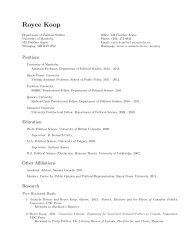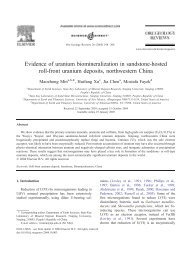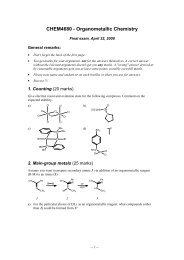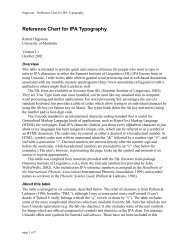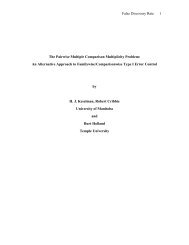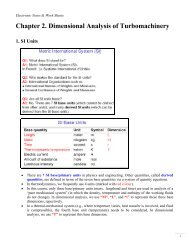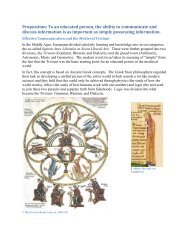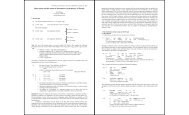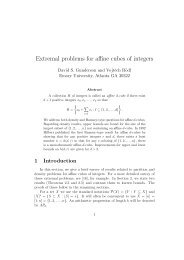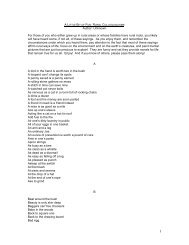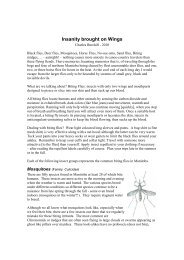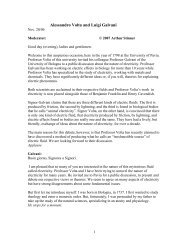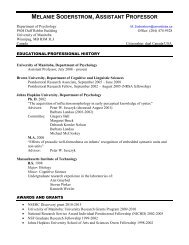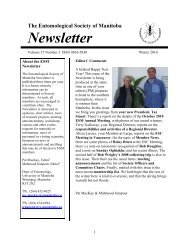Kwadwo Poku Owusu
Kwadwo Poku Owusu
Kwadwo Poku Owusu
You also want an ePaper? Increase the reach of your titles
YUMPU automatically turns print PDFs into web optimized ePapers that Google loves.
<strong>Kwadwo</strong> <strong>Poku</strong> <strong>Owusu</strong><br />
Department of Mechanical & Manufacturing Engineering<br />
Supervisors: Dr. David C. S. Kuhn & Dr. Eric Bibeau
Outline<br />
� Icing and Icing Measurement<br />
� Research Objectives<br />
� Design Approach<br />
�� EExperimental i t l and d Numerical N i l Procedures P d<br />
� Results and Discussion<br />
� Conclusions
Icing and Icing Measurement<br />
� Atmospheric Icing<br />
� Effects of Icing<br />
� Methods of Ice Detection<br />
�� CCommercial i l I Ice DDetection t ti PProbes b
Atmospheric Icing<br />
� Icing Precipitation<br />
� Icing from Sea Water Spray<br />
� Wet Snow Accumulation<br />
�� IIn‐cloud l d IIcing i<br />
[Ahti 2005]
In‐cloud Icing<br />
� Rime Icing<br />
� ‐5°C 5 to ‐12°C<br />
� Low Liquid Water<br />
Content (LWC)<br />
� Feathery in appearance<br />
� L Low ddensity it
In‐cloud Icing cont’d<br />
� Glaze Icing<br />
� 0°C 0 C to ‐5°C 5 C<br />
� High Liquid Water<br />
CContent t t (LWC)<br />
� Clear in appearance<br />
� High density
Effect of Icing on Wind Turbines<br />
� Decrease of power due to modification in<br />
the h aerodynamics d i of f the h blade bl d<br />
� Increased fatigue of the components due to<br />
imbalance in the ice loads<br />
� Chunks of ice thrown off from the blades<br />
can cause serious injuries to people and<br />
wildlife as well as damage g to property p p y
Methods of Ice Detection<br />
� Direct methods ‐ Detects property change<br />
caused by y the accretion of ice. Such<br />
properties include mass and dielectric<br />
constant<br />
� Indirect methods ‐ Based on detecting<br />
weather conditions that lead to icing such as<br />
humidity or detecting the effect of icing<br />
such suc as reduction educt o in power po e ge generated e ated<br />
[ Homola et. al., 2005 ]
Commercial Ice Detection Probes<br />
� Labko Ice Detector 3210C<br />
� Uses Ultrasonic l i Sensitive S i i<br />
wire to detect icing<br />
� Rosemount Model 0871<br />
LH1 Icing Sensor<br />
� Uses Ultrasonic<br />
Vibrating Probe to<br />
detect Icing<br />
Sensor<br />
part<br />
Control<br />
unit<br />
Vibrating<br />
probe p
Research Objectives<br />
� Develop an ice accretion measurement method suitable for<br />
use on meteorological towers based on the changes in<br />
capacitance and resistance between two electrically<br />
charged cylindrical probes<br />
� Use theoretical models to study the changes in capacitance<br />
with ice accretion, and validate these studies using<br />
“modelled” ice growth in a laboratory setting<br />
� Test the proposed method under simulated rime and glaze<br />
ice conditions in the icing wind tunnel
Design Approach<br />
� Conceptual Design<br />
� Measure ice accretion<br />
based on the changes<br />
in capacitance and<br />
resistance between<br />
two electrically<br />
charged cylindrical<br />
probes during an icing<br />
event<br />
Trajectory of air<br />
Supercooled water drops<br />
Sensing<br />
electric<br />
field
Design Approach cont’d<br />
� Numerical Design<br />
� Design icing probe using QuickField simulations<br />
�� Numerically study the variation of capacitance with simple<br />
geometric “modelled” ice shape to define probe design<br />
� Validate numerical results with experimental results based on<br />
acrylic y model of ice<br />
� Experimental Design and Construction<br />
� Construct an ice accretion probe prototype with ancillary equipment<br />
and define the measurement method based on the numerical design<br />
� Experimental Evaluation<br />
� Test the proposed method under simulated rime and glaze ice<br />
conditions di i in i the h iicing i wind i d tunnel<br />
l
NNumerical i l and d EExperimental i l<br />
Procedure
Numerical Electric Field Simulation:<br />
Governing G i Equations E ti<br />
∂<br />
∂ x<br />
⎛<br />
⎜<br />
⎝<br />
ε<br />
x<br />
ε = x ε y<br />
ρρ<br />
U<br />
=<br />
=<br />
∂ U<br />
∂ x<br />
=<br />
charge<br />
electric<br />
⎞<br />
⎟<br />
⎠<br />
+<br />
∂<br />
∂ x<br />
dielectric<br />
⎛<br />
⎜<br />
⎝<br />
density<br />
potential<br />
ε<br />
y<br />
∂ U<br />
∂ y<br />
constant<br />
⎞<br />
⎟<br />
⎠<br />
=<br />
(C/sq (C/sq.m) m)<br />
(V)<br />
−<br />
ρ
Electric Field Boundary Conditions<br />
� Cylinders are defined as<br />
floating g conductors i.e.<br />
equal but opposite potentials<br />
� U= 0 on the external<br />
boundary<br />
� Dielectric constant of 3.1 for<br />
ice was used<br />
� Charges of ‐1C and +1C are<br />
specified<br />
A typical computation domain
Acrylic Model of Ice<br />
Acrylic cylinder sleeves Aluminum probe with acrylic sleeve
Icing Wind Tunnel<br />
Inner duct of the wind icing tunnel
Probe Orientation<br />
Wind and<br />
supercooled<br />
water drop<br />
direction<br />
d<br />
s<br />
d<br />
s<br />
Wind d aand d<br />
supercooled<br />
water drop<br />
direction<br />
Inline orientation Parallel orientation
Experimental Conditions<br />
Temperature<br />
( o C )<br />
Type of icing<br />
event<br />
Liquid water<br />
content,<br />
‐2 (±2) Glaze 2.0<br />
Ambient<br />
velocity (m/s)<br />
Sensor<br />
orientation<br />
LWC, (g/m 3 ) to ambient<br />
5 (±1)<br />
8 (± 1)<br />
10 (± 1)<br />
5 (±1)<br />
air<br />
1. Inline<br />
2. PParallel ll l<br />
‐10 (± (±2) ) Ri Rime 0.8 8<br />
8 ( ± 1) ) 1. IInline li<br />
10 (±1)<br />
2. Parallel
Schematic of the Probe and Ancillary<br />
Equipment E i t<br />
LLead d wires i<br />
Aluminum<br />
Insulator<br />
Hioki 3522‐50 35 5<br />
Capacitance<br />
meter<br />
RS232 cable<br />
Computer
Results and Discussion
Variation of Capacitance with<br />
Center‐to‐center C Distance Di<br />
Capacitance (pF) (<br />
4.8<br />
4.3<br />
38 3.8<br />
3.3<br />
2.8<br />
2.3<br />
187 1.87 237 2.37 287 2.87 337 3.37 387 3.87<br />
Center -to-center distance,s (cm)<br />
Numerical
Electric Field Distribution<br />
(s=1.87 cm)<br />
Numerical
Capacitance Variation with Electrode<br />
Diameter Di t<br />
4.6<br />
Capacitance C (pF) (<br />
4.4<br />
42 4.2<br />
4.0<br />
3.8<br />
36 3.6<br />
d<br />
s<br />
D<br />
Impinging<br />
water drops<br />
0.89 0.99 1.09 1.19 1.29<br />
Diameter of electrode, D (cm)<br />
Numerical
Capacitance Variation with Ice<br />
Thickness Thi k<br />
Capacitance (pF) (<br />
4.9<br />
4.8<br />
47 4.7<br />
4.6<br />
4.5<br />
44 4.4<br />
inline orientation<br />
parallel orientation<br />
0 0.2 0.4 0.6 0.8 1 1.2<br />
Thickness of modelled ice (cm)<br />
t<br />
Inline orientation<br />
t<br />
PParallel ll l orientation i i<br />
Numerical<br />
t
Capacitance Variation with Size of<br />
Acrylic A li Sleeves Sl<br />
(pF)<br />
Capacitance<br />
5.5<br />
5.0<br />
4.5<br />
4.0<br />
3.5<br />
3.0<br />
25 2.5<br />
acrylic inline case<br />
acrylic parallel case<br />
numerical parallel case<br />
1.27 1.37 1.47 1.57 1.67<br />
Outer diameter of acrylic (cm)<br />
Numerical
Mass M of ice accreted<br />
(g)<br />
Icing Rates for Rime Ice<br />
18<br />
16<br />
14<br />
12<br />
10<br />
8<br />
6<br />
4<br />
2<br />
0<br />
5m/s inline<br />
8 m/s inline<br />
10 m/s inline<br />
5 m/s parallel<br />
8 m/s parallel<br />
10 m/s parallel<br />
Temperature ‐10 o C<br />
LWC 0.8 g/m 3<br />
Thickkness<br />
of ice acccreted<br />
(mm)<br />
14<br />
12<br />
10<br />
8<br />
6<br />
4<br />
5 m/s inline<br />
8 m/s inline<br />
10 m/s inline<br />
5 m/s parallel<br />
8 m/s parallel<br />
10 m/s parallel<br />
0<br />
0 2 4 6 8 10 12 14 16 18 20<br />
0 2 4 6 8 10 12 14 16 18 20<br />
Exposure time (minutes) EExposure pos re time (minutes) (min tes)<br />
Mass Thickness<br />
Standard error bars on the 5 m/s parallel case for both cases<br />
2<br />
Experimental
Mass M of ice acccreted<br />
(g)<br />
Icing Rates for Glaze Ice<br />
35<br />
14<br />
30<br />
25<br />
20<br />
15<br />
10<br />
5<br />
0<br />
5 m/s inline<br />
8 m/s inline<br />
10 m/s inline<br />
5 m/s parallel<br />
8 m/s parallel<br />
10 m/s parallel<br />
Temperature ‐2 o C<br />
LWC 2 g/m 3<br />
0 2 4 6 8 10 12 14 16 18 20<br />
Thickkness<br />
of ice acccreted<br />
(mm)<br />
12<br />
10<br />
8<br />
6<br />
4<br />
5 m/s inline<br />
8 m/s inline<br />
10 m/s inline<br />
5 m/s / parallel ll l<br />
8 m/s parallel<br />
10 m/s parallel<br />
Exposure p time ( (minutes) ) Exposure Time (minutes)<br />
2<br />
0<br />
0 2 4 6 8 10 12 14 16 18 20<br />
Mass Thickness<br />
Standard error bars on the 5 m/s parallel case for both cases<br />
Experimental
Variation of Capacitance with Exposure<br />
Time Ti<br />
Capacitaance<br />
(pF)<br />
5.32<br />
5.12<br />
4.92<br />
4.72<br />
4.52<br />
4.32<br />
4.12<br />
3.92<br />
3.72<br />
3.52<br />
5m/s inline<br />
8 m/s inline<br />
10 m/s inline<br />
5 m/s parallel<br />
8 m/s parallel<br />
10 m/s parallel<br />
13.52<br />
Temperature ‐10 5 / i li<br />
oC Temperature ‐2o Temperature 10 C<br />
12.52 5m/s inline<br />
C<br />
LWC 0.8 g/m3 Temperature 2 C<br />
LWC 2 g/m3 0 2 4 6 8 10 12 14 16 18 20<br />
Exposure time (minutes)<br />
Capacitannce<br />
(pF)<br />
11.52 8 m/s inline<br />
10.52 10 m/s inline<br />
9.52 5 m/s parallel<br />
852 8.52 8 m/s parallel<br />
7.52<br />
6.52<br />
5.52<br />
452 4.52<br />
3.52<br />
10 m/s parallel<br />
0 2 4 6 8 10 12 14 16 18 20<br />
Exposure time (minutes)<br />
Rime ice Glaze ice<br />
Experimental
Variation of Capacitance with Mass and<br />
Thickness Thi k for f Rime Ri ice i<br />
Capacittance<br />
(pF)<br />
5.32<br />
5.12<br />
4.92<br />
4.72<br />
4.52<br />
4.32<br />
4.12<br />
3.92<br />
3.72<br />
3.52<br />
5 m/s inline<br />
8 m/s inline<br />
10 m/s inline<br />
5 m/s parallel<br />
8 m/s parallel<br />
10 m/s parallel<br />
Temperature ‐10o Temperature 10 C<br />
LWC 0.8 g/m3 0 2 4 6 8 10 12 14 16<br />
Mass of ice accreted (g)<br />
Capacittance<br />
(pF)<br />
5.32<br />
5.12 12<br />
4.92<br />
4.72<br />
4.52<br />
4.32<br />
4.12<br />
5 m/s inline<br />
8 m/s inline<br />
10 m/s inline<br />
5 m/s parallel<br />
8 m/s parallel<br />
10 m/s parallel<br />
3.92<br />
3.72<br />
3.52<br />
0 2 4 6 8 10 12 14 16<br />
Thickness of ice accreted (mm)<br />
Mass Thi Thickness k<br />
Experimental
Variation of Capacitance with Mass and<br />
Thi Thickness k f for Gl Glaze iice<br />
Capacitance<br />
(pF)<br />
12.52<br />
11 11.522<br />
10.52<br />
9.52<br />
8.52<br />
7.52<br />
6.52<br />
5.52<br />
4.52<br />
3.52<br />
5 m/s inline<br />
8 m/s inline<br />
10 m/s inline<br />
5 m/s parallel<br />
8 m/s parallel<br />
10 m/s parallel<br />
Temperature ‐2o Temperature 2 C<br />
LWC 2 g/m3 0 5 10 15 20 25 30 35<br />
Mass of ice accreted (g)<br />
Capacitaance<br />
(pF)<br />
12.52<br />
11.52<br />
10.52<br />
9.52<br />
8.52<br />
7.52<br />
6.52<br />
5.52<br />
5 m/s inline<br />
8 m/s inline<br />
10 m/s inline<br />
5 m/s parallel<br />
8 m/s parallel<br />
10 m/s parallel<br />
4.52<br />
3.52<br />
0 2 4 6 8 10 12 14 16<br />
Thickness of ice accreted (mm)<br />
M Mass Thi Thickness k<br />
Experimental
Sensitivity of Probe to Ice Accretion‐<br />
Ri Rime ice i<br />
Capacitannce<br />
per Mass (pF/ /g)<br />
0.14<br />
012 0.12<br />
0.10<br />
0.08<br />
0.06<br />
0.04<br />
0.02<br />
0.00<br />
0 2 4 6 8 10 12 14 16 18 20<br />
Exposure time (Minutes)<br />
per Thickness (ppF/mm)<br />
0.30<br />
5 m/s inline inline00.25 25<br />
8 m/s inline<br />
0.20<br />
10 m/s inline<br />
5 m/s parallel 0.15<br />
8 m/s parallel<br />
0.10<br />
10 m/s parallel<br />
0.05<br />
Capacitance<br />
0.00<br />
0 2 4 6 8 10 12 14 16 18 20<br />
Exposure time (minutes)<br />
Mass Thickness<br />
5 m/s inline<br />
8 m/s inline<br />
10 m/s inline<br />
5 m/s parallel<br />
8 m/s parallel<br />
10 m/s parallel<br />
Experimental, Temperature -10 o C<br />
LWC 0.8 g/m 3
Sensitivity of Probe to Ice Accretion‐<br />
Glaze Gl ice i<br />
Capacitaance<br />
per Mass (ppF/g)<br />
0.45<br />
0.40<br />
0.35<br />
0.30<br />
0.25<br />
0.20<br />
0.15<br />
0.10<br />
0.05<br />
0.00<br />
0 2 4 6 8 10 12 14 16 18 20<br />
Exposure time (minutes)<br />
Mass<br />
Capacitance perr<br />
Thickness (pF/ /mm)<br />
1.68<br />
5 m/s inline<br />
1.47<br />
8 m/s inline<br />
1.26<br />
10 m/s inline<br />
1.05<br />
5 m/s parallel 0.84<br />
8 m/s / parallel ll l 063 0.63<br />
10 m/s parallel<br />
0.42<br />
0.21<br />
0.00<br />
0 2 4 6 8 10 12 14 16 18 20<br />
Exposure time (minutes)<br />
Thickness<br />
5 m/s inline<br />
8 m/s inline<br />
10 m/s inline<br />
5 m/s parallel<br />
8 m/s parallel<br />
10 m/s parallel<br />
Experimental, Temperature -2 o C<br />
LWC 2.0 g/m 3
Resistance Resistance Variation with with Exposure Exposure<br />
Time<br />
Resiistance<br />
(MΩ)<br />
40<br />
35<br />
30<br />
25<br />
20<br />
15<br />
10<br />
5<br />
0<br />
5 m/s rime ice<br />
8 m/s rime ice<br />
5 m/s / glaze l ice i<br />
8 m/s glaze ice<br />
0 2 4 6 8 10 12 14 16 18 20<br />
Exposure time (minutes)<br />
Experimental
OOptimal ti l PProbe b CConfiguration fi ti<br />
Length of cylinder (cm)<br />
Number of cylinders<br />
Center‐to‐center, s (cm)<br />
Diameter Diameter, d (cm)<br />
Orientation to supercooled<br />
water drops<br />
15<br />
2<br />
1.87 8<br />
1.27<br />
Parallel
Conclusions<br />
� A method based on capacitance and resistance can<br />
be use to detect icing as well as distinguishing<br />
bt between the th two t types t of f in‐cloud i l d iicing i<br />
� The sensitivity of the prototype probe depends on<br />
factors such as center center‐to‐center to center distance distance, size of<br />
probe cylinders and location of the ice deposits<br />
�� The sensitivity of the prototype probe to ice<br />
accretion is high in the first few minutes of exposure<br />
�� The icing rates increased with wind speed
Questions ?



